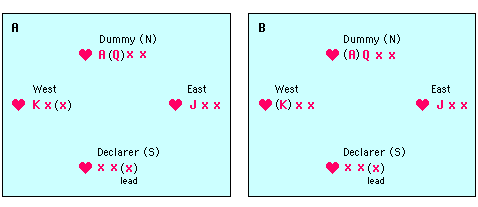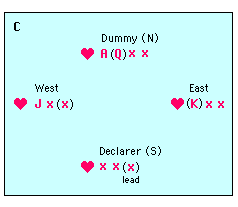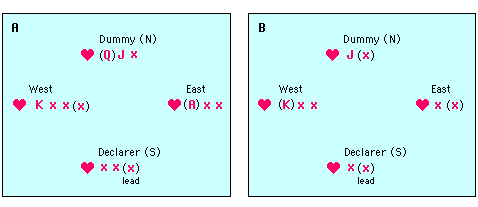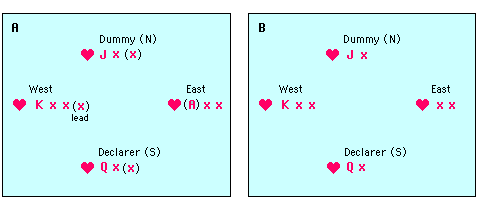(Down Fast - Up - Top)
BR 9.3 - Indirect Finesse against the King
Definition
Two cards separated by a one card gap is called a tenace. For example A Q - K J - Q 10 - J 9 - etc.
Finesse Situation 4 - Ace Queen tenace against the King
Here the Hands of West and Dummy from situation 1 are reversed.

Once again lead a small Heart from Declarer's hand
- If West plays a low Heart, you win the trick with the Queen from Dummy (Diagram A).
- If, on the other hand, West plays the King instead, you capture it with Dummy's Ace, promoting the Queen as a winner for the next trick (Diagram B).
- If East holds the Heart King instead (Case C below) there is nothing you can do and Dummy's Queen will be captured by the Opponent.

This type of Finesse has a 50% chance of success. Half the time the missing King will be in West's hand, half the time it will be in East's hand.
(Down - Up - Top)
Finesse Situation 5 - Ace and Queen in separate hands against the King
In general when the honour cards in a suit are divided equally amongst the four players (as in the example below) it is usually best to avoid leading that suit. Leading such suit often results in giving an extra trick away to the Opponents. Try instead to make them lead that suit, so that your side will have the advantage.
However when you do have to lead such a suit (for example to make just one more extra trick), then take an indirect finesse. In the example below lead a low card from Declarer's hand.
- If West plays the King (winning the trick), play low in Dummy. Next time round the Heart Queen will make an extra trick. (Diagram A)
- If West plays low, play Dummy's Queen. It will win the trick provided West holds the King (Diagram B)
- If East holds the King, Dummy's Queen will not make a trick.

When you hold 8 or more cards in the suit with above Honour distribution it is best to first lead the Ace. It may drop a singleton King. Then follow up with a low card from Declarer in an indirect finesse to Dummy's Queen.
The play below is something you should definitely not do.
Against good defence leading the Queen from Dummy will never make an extra trick.
- Either West will capture the Queen and win the trick with his King (Diagram A),
- or East will cover the Queen with his King, forcing Declarer to win the trick with the Ace (Diagram B). By sacrifycing his King East prevents Declarer making a second trick in the suit, while at the same time promoting West's Jack as a winner for the Defence.

(Down - Up - Top)
Finesse Situation 6 - Queen and Jack against the Ace and King
This is a very common card holding. Obviously when you first lead the Queen from Dummy and at a later trick the Jack you will loose the trick both times. But an indirect finesse play has a 75% chance of making at least one trick.
In the example below lead a small card from Declarer's hand.

- If West plays low (which he should, unless he holds both A and K or a K x doubleton), play Dummy's Queen (or Jack). Most of the time this will be captured by East's Ace (Diagram A).
- When next on lead Declarer plays a second small Heart from his hand. If West plays his King, play a low card in Dummy (Diagram B). The Jack is now a sure winner for the next Heart trick.
If West plays low (instead of the King), play Dummy's Jack. It will make the trick provided West rather than East has the King.
With two danger cards held by the Opponent 50% of the time they will be divided equally between the two hands. The other 50% of the time both cards will be in one hand, 25% of the time by West and 25% of the time by East.
Only when East holds both the A and K (25% chance) will you end up losing both Dummy's Q and J.
(Down - Up - Top)
Finesse Situation 7 - Q and J in separate hands against A and K
This is a situation where you should not start playing the suit yourself. If you do you are most likely to loose the lot.
Instead be patient. Sooner or later the Opponents will play the suit. As soon as their first card is on the table (be it a high or a low one) you are assured of a trick.
In the example below West leads a small Heart.

- You must play low in Dummy, while East must go up with his Ace to win the trick (Diagram A).
(If East plays low you win the trick in Declarer's hand with the Queen).
- Now a Heart trick is assured, for you still hold both the Q and J. One of these will force out the King and the other will win a trick.
It is a powerful example of not leading a suit when the honour cards are equally divided over the four hands.